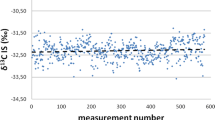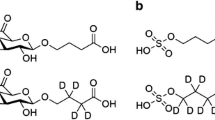Abstract
Benfluorex [1-(m-trifluoromethylphenyl)-2-(β-benzoyloxyethyl)aminopropane] has been widely used for the treatment of atherogenic metabolic disorders and impaired carbohydrate metabolism (particularly in obese type-II diabetic patients) as well as an anorectic drug. Due to its potentially performance-enhancing properties, benfluorex has been added to the list of prohibited compounds and methods of doping by the World Anti-Doping Agency (WADA) in 2010, necessitating the implementation of the drug as well as its major metabolites into routine doping control procedures. In the present study, human urinary metabolites of benfluorex were characterized by gas chromatography–electron ionization–mass spectrometry (GC-EI-MS) as well as liquid chromatography–electrospray ionization–high resolution/high accuracy tandem mass spectrometry (LC-ESI-MS/MS). Commonly employed sports drug testing approaches consisting of liquid–liquid extraction followed by GC-MS or urine dilution and immediate LC-MS/MS analysis were expanded and validated with regard to specificity, recovery (48–54%, GC-MS only), intra- and interday precision (<25%), limits of detection (5–8 ng/mL for LC-MS/MS and 80 ng/mL for GC-MS), and ion suppression (for LC-ESI-MS/MS only) to allow the detection of benfluorex metabolites 1-(m-trifluoromethylphenyl)-2-(2-hydroxyethyl)aminopropane (M1), 1-(m-trifluoromethylphenyl)-2-(2-carboxymethyl)aminopropane (M2), and 1-(m-trifluoromethylphenyl)-2-aminopropane (M3) as well as the glucuronic acid conjugate of M1.





Similar content being viewed by others
References
Boulogene LB, Hugon P, and Le Douarec J-C (1971) in United States Patent Office, Science Union et Cie Societe Francaise de Recherche Medicale Suresnes, United States
Sittig M (1988) Pharmaceutical manufacturing encyclopedia. Noyes, New Jersey, p 140
Brindley DN (1993) “Mechanisms for the effects of benfluorex on the obese–diabetic–dyslipidemic syndrome”, Diabetes Metab Rev 9 Suppl 1, 51S
Boutet K, Frachon I, Jobic Y, Gut-Gobert C, Leroyer C, Carlhant-Kowalski D, Sitbon O, Simonneau G, Humbert M (2009) Fenfluramine-like cardiovascular side-effects of benfluorex. Eur Respir J 33:684
Noize P, Sauer M, Bruneval P, Moreau M, Pathak A, Bagheri H, Montastruc JL (2006) Valvular heart disease in a patient taking benfluorex. Fundam Clin Pharmacol 20:577
EMEA (2009) European Union, London
TAS-CAS (2009) Tribunal Arbitral du Sport—Court of Arbitration for Sport, Lausanne
World Anti-Doping Agency (2010) “The 2010 Prohibited List”, http://www.wada-ama.org/Documents/World_Anti-Doping_Program/WADP-Prohibited-list/WADA_Prohibited_List_2010_EN.pdf, 14-01-2010
Thevis M, Kuuranne T, Geyer H, Schänzer W (2009) Annual banned-substance review: the Prohibited List 2008—analytical approaches in human sports drug testing. Drug Test Anal 1:4
Thevis M, Kuuranne T, Geyer H, Schänzer W (2010) Annual banned-substance review: analytical approaches in human sports drug testing. Drug Test Anal 2:149
Beckett AH, Shenoy EV, Brookes LG (1971) Determination of N-(2-benzoyloxyethyl)-norfenfluramine (JP 992) and its metabolites in urine. J Pharm Pharmacol 23:950
Beckett AH, Shenoy EV, Brookes LG (1972) The absorption, metabolism and elimination of (plus minus)-N-(2-benzoyloxyethyl)norfenfluramine (JP992) in man. J Pharm Pharmacol 24:281
Orsiere T, Chauvet M, Dell’Amico M, Lafont H, Bourdeaux M (1995) In vitro influence of benfluorex and its main metabolites on rat liver microsomal membrane properties. Chem Biol Interact 97:297
Nolteernsting E, Opfermann G, and Donike M (1996) In recent advances in doping analysis Donike M, Geyer H, Gotzmann A, and Mareck-Engelke U (eds.), Sport & Buch Strauss, Cologne Vol. 3:pp. 369
Donike M, Jaenicke L, Stratmann D, Hollmann W (1970) Gas chromatographic detection of nitrogen-containing drugs in aqueous solutions by means of the nitrogen detector. J Chromatogr 52:237
Donike M (1970) Temperature programmed gas chromatographic analysis of nitrogen-containing drugs: the reproducibility of retention times (I). Chromatographia 3:422
Kromidas A (1999) Validierung in der Analytik. Wiley, Weinheim
Dams R, Huestis MA, Lambert WE, Murphy CM (2003) Matrix effect in bio-analysis of illicit drugs with LC-MS/MS: influence of ionization type, sample preparation, and biofluid. J Am Soc Mass Spectrom 14:1290
Matuszewski BK, Constanzer ML, Chavez-Eng CM (2003) Strategies for the assessment of matrix effect in quantitative bioanalytical methods based on HPLC-MS/MS. Anal Chem 75:3019
Thevis M, Sigmund G, Geyer H, Schänzer W (2010) Stimulants and doping in sport. Endocrinol Metab Clin North Am 39:89
Hemmersbach P, de la Torre R (1996) Stimulants, narcotics and β-blockers: 25 years of development in analytical techniques for doping control. J Chromatogr B 687:221
World Anti-Doping Agency (2008) “Minimum required performance levels for detection of prohibited substances”, http://www.wada-ama.org/rtecontent/document/MINIMUM_REQUIRED_PERFORMANCE_LEVELS_TD_v1_0_January_2009.pdf, 24-11-2008
Beckett AH, and Brookes LG (1967) “The absorption and urinary excretion in man of fenfluramine and its main metabolite”, J Pharm Pharmacol 19: Suppl 42S
Brownsill R, Wallace D, Taylor A, Campbell B (1991) Study of human urinary metabolism of fenfluramine using gas chromatography-mass spectrometry. J Chromatogr 562:267
Marchant NC, Breen MA, Wallace D, Bass S, Taylor AR, Ings RM, Campbell DB, Williams J (1992) Comparative biodisposition and metabolism of 14C-(+/−)-fenfluramine in mouse, rat, dog and man. Xenobiotica 22:1251
Hammerum S, Henriksen T (2000) The rearrangement and simple cleavage of metastable octanamine radical cations. Int J Mass Spectrom 199:79
Hammerum S, Nielsen CB (2005) Intramolecular hydrogen bonding and hydrogen atom abstraction in gas-phase aliphatic amine radical cations. J Phys Chem A 109:12046
Hammerum S, Norrman K, Solling TI, Andersen PE, Jensen LB, Vulpius T (2005) Competing simple cleavage reactions: the elimination of alkyl radicals from amine radical cations. J Am Chem Soc 127:6466
Gohlke RS, McLafferty FW (1962) Mass spectrometric analysis—aliphatic amines. Anal Chem 34:1281
Acknowledgments
The study was conducted with support of the Federal Ministry of the Interior of the Federal Republic of Germany, the Ministry of Sport and Tourism of the Republic of Poland, and the Manfred-Donike Institute for Doping Analysis (Cologne, Germany).
Author information
Authors and Affiliations
Corresponding author
Additional information
Published in the special issue Anti-Doping Analysis with Guest Editor Mario Thevis
Rights and permissions
About this article
Cite this article
Thevis, M., Sigmund, G., Gougoulidis, V. et al. Screening for benfluorex and its major urinary metabolites in routine doping controls. Anal Bioanal Chem 401, 543–551 (2011). https://doi.org/10.1007/s00216-010-4455-4
Received:
Revised:
Accepted:
Published:
Issue Date:
DOI: https://doi.org/10.1007/s00216-010-4455-4




